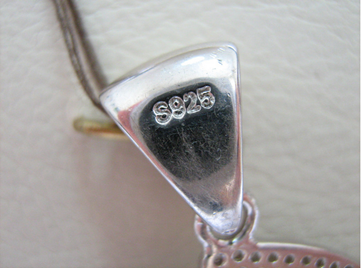As a refinery with almost 40 years of experience, we have a range of high accuracy assays at our disposal to determine the exact purity levels of gold, silver, platinum, palladium, or rhodium in anything a client may bring to our storefront. However, if you want to check the authenticity of some estate jewelry or flatware sets you have at home, you can get away with not using the types of high-tech assay equipment we’d usually recommend. When it comes to silver, there are several quick and easy ways to separate lookalikes from genuine articles.


Check for a Hallmark
Look for purity stamps or hallmarks. These are usually very small, and placed inconspicuously on the inside or underside of the item, so look closely. Silver will be stamped with 950, 935, 925, 900, 835, or 800 – indicating the percentage of pure silver.
The Magnet Tests
Place a neodymium magnet (you’ll want something much stronger than a refrigerator magnet) on the item you want to test. Pure silver will not be attracted to the magnet. However, there are many silver-colored metals that are non-magnetic, so you’ll want to do additional tests to make sure you have real silver.
An interesting variation of this test is the “sliding magnet” test. If the object has a large flat surface area (like a bullion bar or flatware knife), hold it at a 45-degree angle and place the magnet at the top. If the object is silver, the magnet should descend slower than you’d expect. This is because silver is paramagnetic and will create a small amount of electromagnetic resistance – generating a “braking” effect that causes the magnet to slowly slide down the surface. If the object is fake silver, the magnet will either stick, or slide down quickly.
The Ice Test
Place a fresh ice cube on the object you want to test and see how quickly it melts at room temperature. Silver has the highest thermal conductivity of any metal. If the object is silver, the cold will rapidly transfer from the ice to the silver – causing it to melt much faster than ice placed on a base metal like aluminum or steel.
The “Ping” Test
This test is a favorite among the old pros in our industry. Silver has a distinctive acoustic resonance, producing a clear, sustained ring when struck. Gently tap the silver item with another metal object and listen to the sound it produces. Genuine silver should make a high-pitched, long-lasting ring. Base metals will produce a dull, short sound.
The Bleach Test
Unlike other precious metals like gold and platinum, silver will tarnish or oxidize easily. Although silver tarnish is easy to clean, we wouldn’t recommend this test on collectible items like coins or bullion. Place a drop of bleach on the object. If it’s silver (or silver-plated) a black spot of tarnish will appear almost instantly.
When using these three techniques to test for silver, take the results with a pinch of salt. For example, silver-plated or silver-clad items can pass many of these tests. When you need to be certain your silver is real, a professional jeweler, pawnbroker, or metal refiner like us can perform more conclusive testing.
